The Feature Films of Hayao Miyazaki
Given the enormous volume of work produced by Miyazaki, and the relatively small fraction ever to have been released outside his native country, it is impossible to adequately cover his entire output. However, as most of his theatrical films have become available, through diverse routes, and as these movies reflect most clearly the man behind them, they deserve to be discussed in greater detail. Do bear in mind that these works are only a selection – for example, readers are recommended to try and find the ‘Sherlock Hound’ episodes Miyazaki did as a co-production with Italian TV, which were released on CIC Video and so can occasionally be found in video stores.
Lupin III: Castle of Cagliostro
US release, dubbed, Streamline, $29.99
“Breaking down an entire, huge building is a form of motivation. Such motivations is like the reaction to suppressed impulses. I don’t feel that I have to make films that are constructive, destructive films are fine by me, too, because it is natural to destroy a huge thing. But, the constraints of living in a suppressed society aside, I’m hoping to single out motivations for dreams, desires and hopes”
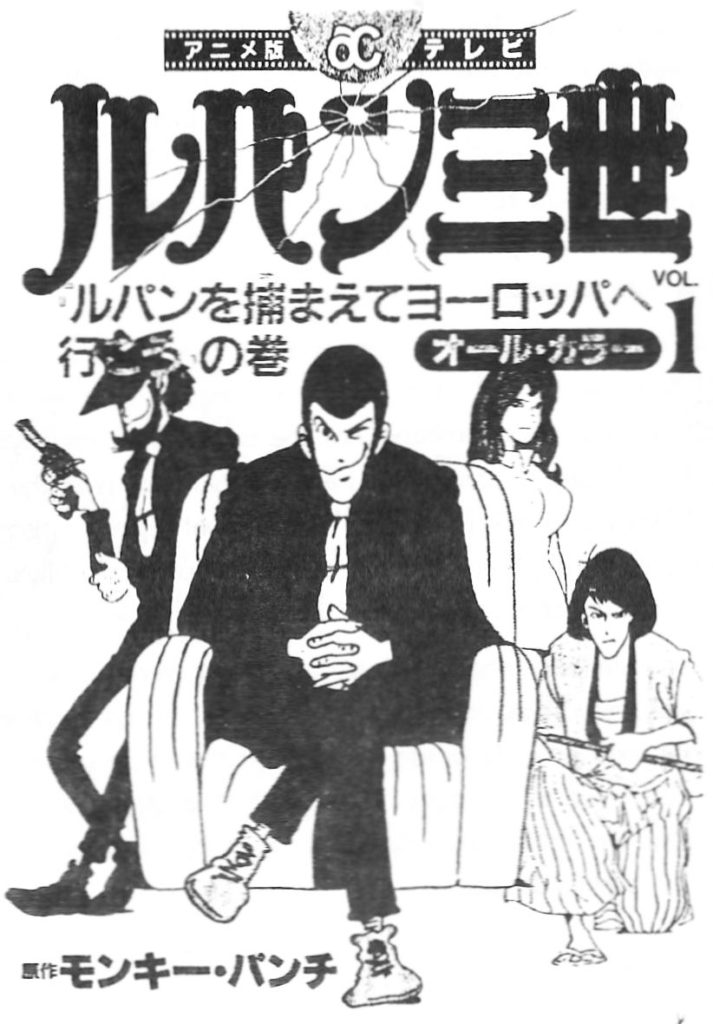
This film took only six months to make, from pre-production to completion. That’s fast, even by anime standards, and it’s lightning speed for Miyazaki, who habitually takes 12 to 18 months per movie. Given this, it’s remarkable that the quality of the end result is almost indistinguishable from Miyazaki’s other works.
The hero is Lupin III, a descendant of Arsene Lupin (a character created by French author Maurice Leblanc at the turn of the century). Like his ancestor, Lupin III is a gentleman thief of high intelligence, and high morals too – except with regard to other people’s valuables! He, together with sidekick Jigen, rob a casino only to discover the money is all counterfeit. They head to the principality where the forgeries are said to originate, only to find themselves rescuing a lady in a wedding dress; this soon leads them into deep mystery and high adventure.
This is a superbly entertaining piece of fluff. Comedy, as mentioned, is perhaps the area where animation can beats reality hands down, since there are no limits, and ‘Castle’ revels in the freedom. All the characters here are memorable: Fujiko, the freelancing female thief, Zenigata, the Interpol detective who’s life is dedicated to capturing Lupin but who ends up working with him, but above all, Lupin III, arguably the best male character in anime. If the maker of ‘Hudson Hawk’ had any sense, it might have ended up looking something like this. B+
Nausicaa of the Valley of Wind
UK release: Warriors of the Wind, Vestron Video – 7.99
“I’m not making movies just to make appeals on particular problems. The close relationship between nature and mankind is something we should be aware of as people living in the present-day, regardless of whether or not we make movies.”
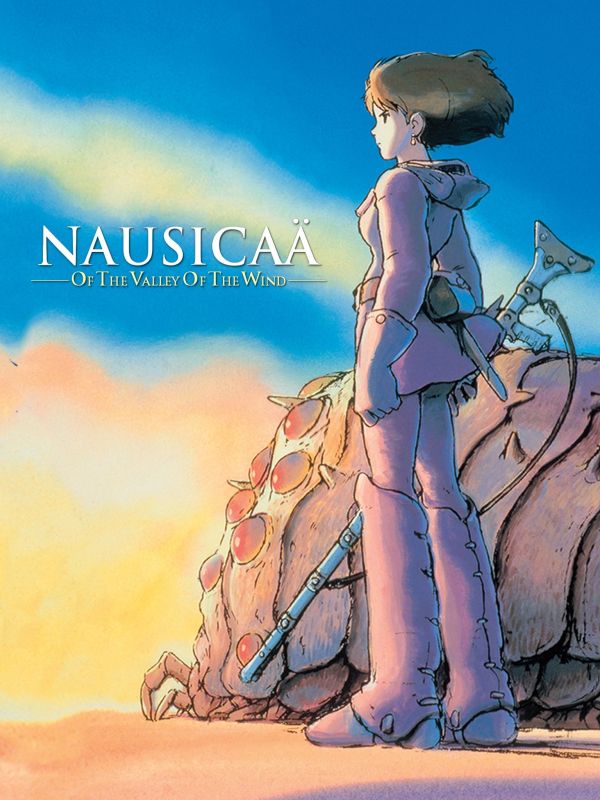
This was reviewed way back in TC6 – or at least, 3/4 of it was. What I didn’t realise at the time was the savage trimming ‘Warriors of the Wind’ had undergone. It’s 25 minutes shorter than the original Japanese version, and it says a lot about ‘Nausicaa’ that ‘Warriors’ is at all watchable. In it’s complete version – 116 minutes, letterboxed, undubbed – it blossoms into perhaps the only truly “green” film yet made. For those without a TC6 to refer to (what took you so long to get here?), a brief re-review. Set post-holocaust, when nature has reclaimed all but fragments of the Earth under a “toxic forest”, Nausicaa is princess of one of the few remaining inhabitable areas.
She feels an attraction to the toxic forest, but it is threatened by the actions of a nearby kingdom, who plan to resurrect pre-devastation technology to destroy it, little realising the dangers of their actions. This illustrates perfectly the imagination anime permits; Miyazaki creates an entire world: plants, animals, insects, fungi, transport, all with painstaking detail. All the characters are plausibly constructed, with justifications worthy of real people. Even in the truncated version, this deserves B+, in the full-blown “director’s cut”, we’re looking at an A.
Laputa
No UK release yet, it’s on Island World’s target list!
“I had always wanted to make a movie about a flying city in the sky, perhaps because of the books I read while I was young. Laputa, the city, was from “Gulliver’s Travels”. At first, I thought about a European palace that suddenly floated up in the sky. The I drew a picture following the description in “Gulliver’s Travels”, but it was just an ordinary island, and too boring”.
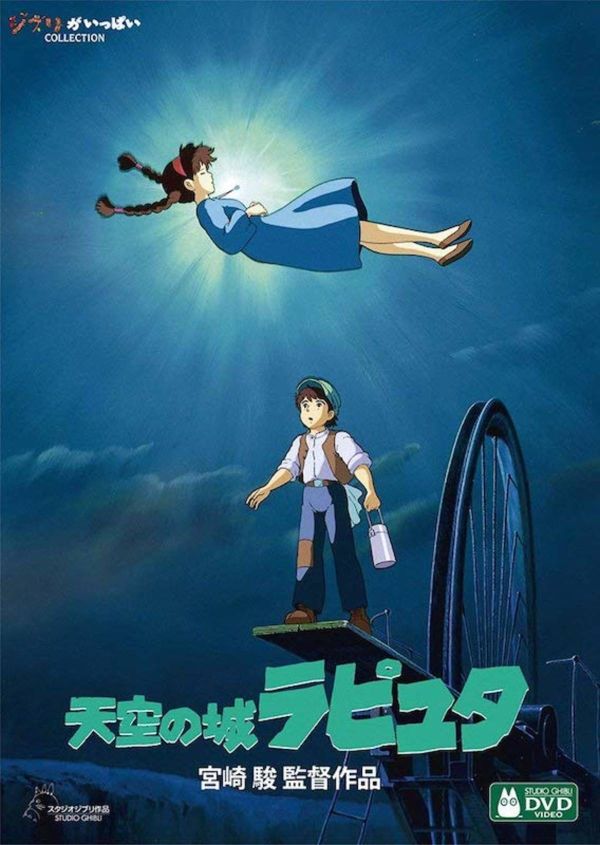
Miyazaki’s work ethic is famous, even in Japan. During the making of ‘Laputa’, he racked up 14-hour days for six months non-stop, not just drawing the story boards, but re-doing his staff’s material where he felt they were deficient. The end result is truly “A Hayao Miyazaki Film”, and is worthy of the title.
Set around the turn of the century, it’s about the search for Laputa, a “legendary” city which floats in the sky and dates from an unknown era, with technology far in advance of anything then available. When a sample of this falls to earth, a descendant of the Laputian kings seeks to reclaim his heritage for his own ends. To do this, he kidnaps Sheeta, the rightful heir to Laputa, though she is unaware of it, which brings him into conflict with Pazu, the son of an aviator who glimpsed the city once, who wants to find Laputa to prove his father was not insane.
There is a lot more to it than that, Miyazaki makes full use of the two hours to cram in more story than you’d think possible, yet it never becomes overweighty. The film is the perfect example of Miyazaki’s philosophy: “I do not make movies with the intention of presenting any messages to humanity. My main aim in a movie is to make the audience come away from it happy”.
Though not available in this country on video, it has been shown on TV in most regions, albeit in a slightly trimmed format. But it still remains a masterpiece, and one of the best examples ever of what can be done with animation. And if the setting for Laputa seems vaguely familiar, it’s probably because Miyazaki travelled to Wales in May 1985, to look at locations! A
My Neighbour Totoro
No UK release yet, but it’s on several company’s target lists!
“I don’t feel interested in outer space movies, since all that is in space is darkness and not much else. Because of this, all my animation and manga involve the land, the seas and the skies. They all revolve around what happens on Earth”
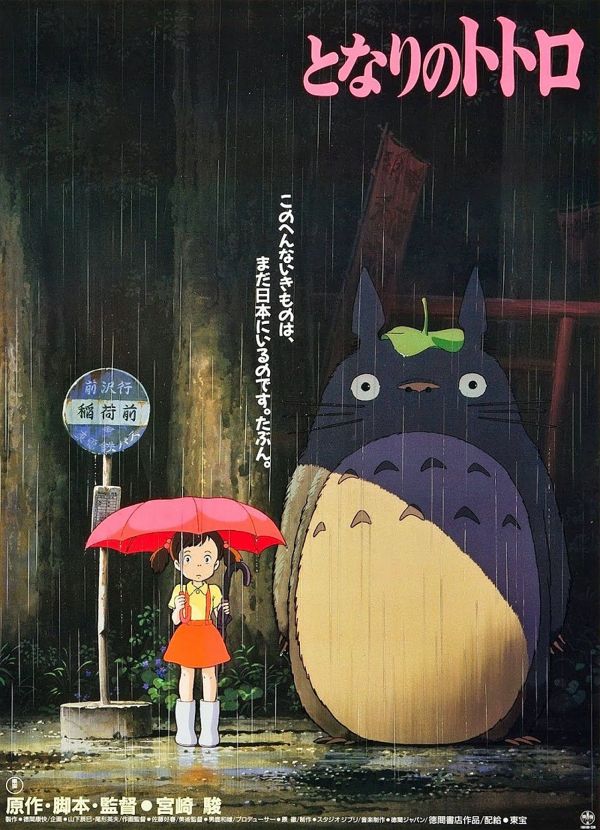
I’ve heard rumours that Disney bought up the American rights to this movie and sat on them, purely because they regarded it as too much of a threat to ‘Aladdin’. This may or may not be true, but it’s plausible, as ‘Totoro’ beats any of Disney’s recent films hands down (no dancing candlesticks or stupid musical numbers here). After the massive epic that was ‘Laputa’, this is a totally different movie, on a much smaller, and personal, scale.
Two small girls go with their father to stay in the country, as Mother is ill in hospital. They stay in an old house, and meet the family of Totoros who inhabit the nearby forest. Now, what’s a Totoro? Good question. Er, um, it’s kinda like a cat. Except it can be enormous, up to maybe twenty feet tall. I think it’s some Japanese folk thang. Whatever it is, it’s main distinguishing feature is that it is utterly, utterly, utterly, cute.
What stops the film from descending into whimsy? Hard to say; it may be partly autobiographical as Miyazaki’s own mother suffered from spinal tuberculosis for nine years when Hayao was young, and she spent much of the time in hospital. Certainly, it’s straight from the heart. Perhaps Miyazaki tapped into some unconscious common imagery, but the result is absolutely delightful. It’s a non-stop parade of wonders, including perhaps Miyazaki’s best creation – the Cat Bus, a multilegged creature with a grin a mile wide, looking like something designed by David Cronenberg on ecstacy.
Few films are capable of melting my granite heart, but ‘Totoro’ reduces this writer to the consistency of a packet of sat-upon marshmallows every time. Which is astonishing, given that this unashamed wallow in nostalgia is for a land on the other side of the globe, and a time before I was born. Miyazaki is the only director I can think of to have directed three films we’ve rated as A (get the feeling this guy is good?); but for ‘Totoro’, this is still not enough, it can only be A+.
Kiki’s Delivery Service
No UK release, Channel 4 were negotiating it’s purchase
Japan Times, August 29, 1989 – “In his latest film, Miyazaki reaches new heights of not only physical but psychological realism…Miyazaki explores states usually considered the province of ‘live’ movies…”Kiki’s Delivery Service” is more than a place to park the kids for two hours – it is a surprisingly moving celebration of the animator’s art that deserves a wider audience”.

Hmmm. Well, each to their own. Perhaps a more telling quote is one from an interview Miyazaki gave in October 1989, when he said, “I want to see whether or not I can make a movie without any action”. I think “Kiki” probably just about counts. But I could live without that – after all, ‘Totoro’ is not exactly action-packed – if there was something to compensate for it. And that’s where “Kiki” fails to deliver(!): the characters are distinctly ho-hum, the plot is distinctly ho-hum and only the animation itself is anything above average.
Trainee witch Kiki goes to the city to seek her fortune. She meets some people. She has some mild adventures (losing her cat, for example). She finds she can be happy despite her lack of spell-casting ability. If this sounds like a pretty naff TVM, I’m pitching it about right. Remove all conflict and struggle from a movie and it takes very careful plot and character design to hold the audience’s interest. ‘Totoro’ managed it because every sequence held a wonderful surprise, but, in Kiki, everything pans out exactly as you’d expect, and the result as far as I’m concerned is Miyazaki’s most forgettable movie to date. D-
Porco Rosso
No UK release
“On board a rundown bi-plane, with only one torpedo loaded, fighting a big task force for one’s pride, while knowing all the while how foolish it is – it will be a breathlessly exciting film, the kind of movie that makes you want to say, “Ah! That was amazing, I want to watch it again””
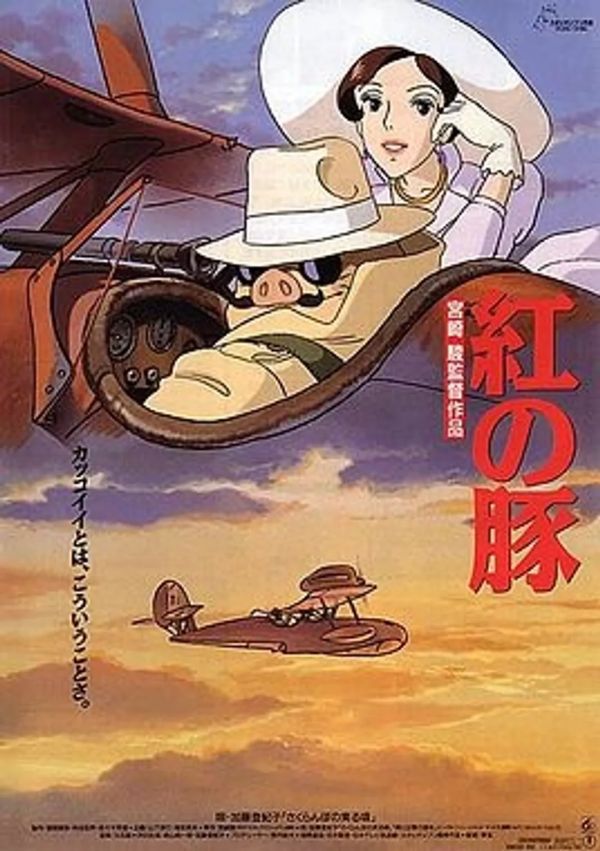
‘Porco Rosso’ represents a return by Miyazaki to the action/comedy genre in which he started, after a long period when his aim, expressed with a wry grin, was to make “films which would let me get more famous awards each time”. ‘Porco’ is first and foremost an adventure story, set in Italy during the 1930’s, and is about the heroes and villains, pirates and aces who flew in that era, a theme which gives Miyazaki plenty of opportunity to indulge in his passion for airplanes and flight. It’s been said that the hero is based on Miyazaki himself, or at least his dreams; there may be some basis in fact for such statements, but I feel the same thing could be said for almost any of the heroes, or indeed the heroines, in his previous work.
It’s especially dubious given the twist in ‘Porco Rosso’. The hero is a pig. Literally. He was once human, but after a strange (near-death?) experience during a dog-fight, he found himself with a pig’s features. This is a nice idea, but nothing much is ever made of it, beyond a very eerie sequence where he tells of his transformation. Otherwise, it’s business as usual as he rescues a gang of pirates from some schoolgirls (sic!), avoids the attentions of the fascist government, and fights for the honour of his friends.
It’s effective enough stuff, and after the “still life” that was ‘Kiki’, it’s a relief to see him rediscover the art of things happening. These “things” however, don’t seem to link into each other as well as in his best movies, the scenes between the set-pieces seem a little contrived, and the political subtext is cringeworthy (“I’d rather be a pig than a fascist”). But even flawed Miyazaki is still highly enjoyable! B-
“I really don’t know why my works are so highly regarded. But, then, there’s no guarantee that I will continue to enjoy acclaim. Many times I’ve waited for younger filmmakers of great promise to come along, and I’ve even tried fostering them – but to no avail. I myself intend to continue making films. I have no idea how long I can go on, or what the next generation holds…”